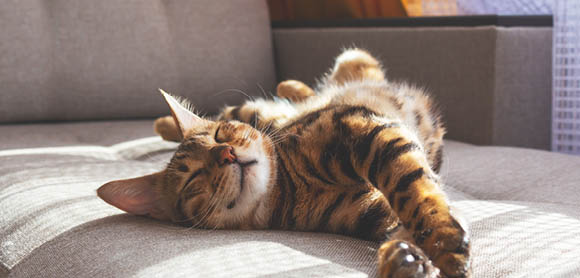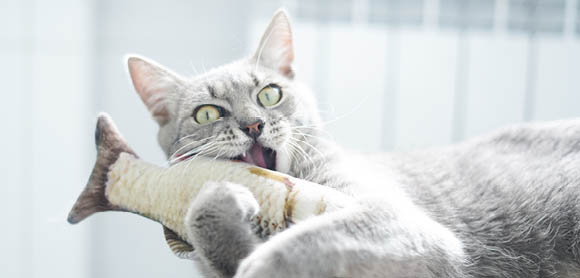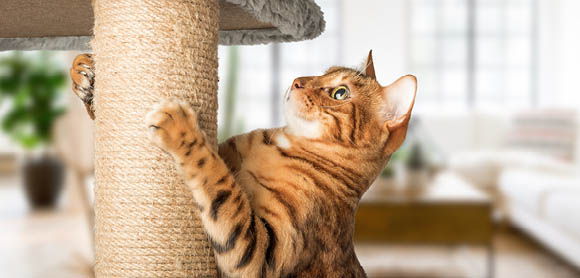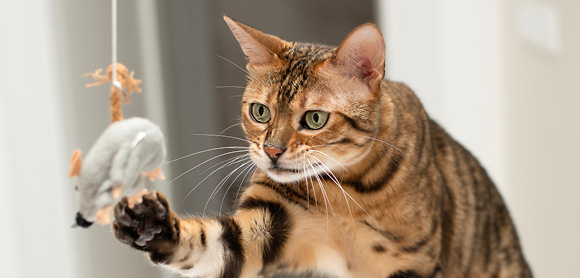If you’ve chosen to keep your cat indoors, here’s everything you need to know about making sure they’re as happy and healthy as possible.

The great outdoors provides plenty of smells, sights and sounds to keep cats mentally and physically stimulated. But for some cats, it’s not the best environment. Indoor cats still need to express their natural behaviours though, which means owners need to spend a little more time making sure that’s possible.
Keeping cats indoors
Many cat owners choose to keep their pets indoors, for a wide variety of reasons. Some cats live indoors permanently, while others may stay indoors for the winter. For owners of indoor cats, one of the most important aspects of responsible pet ownership is ensuring your cat still has opportunities to behave as naturally as possible.
How to keep indoor cats entertained
The first step is to make sure your home offers plenty of places for your cat to climb, rest and hide. If you have multiple indoor cats, they must have enough resources – always provide an additional spare litter tray, food and water bowl, and make sure these are spread around the house.
You’ll also need to spend time making sure your cat has plenty of things to see and do. One of the best ways to achieve this is to set aside time to interact and play with your cat. This not only provides them with mental stimulation but can improve the bond between you.
Short training sessions are also a great way to keep your cat entertained. These don’t need to be long sessions – a couple of minutes a few times a day is plenty. It’s also important to match your cat’s pace. Some will love playing or learning new tricks and will be happy with a few short sessions per day. Others will be happy with one short session. Always make sure your cat has somewhere they can go to rest alone, and respect their need for space when they walk away.

Need some inspiration? Here are three fun activities to try.
Create a cat hammock
Many cats love to climb and sit up high, and a DIY hammock can be a fun place for them to rest. All you’ll need is a worn-out, stretchy T-shirt, some scissors and a sturdy chair. Cut open the shoulders of the T-shirt and extend this cut 15-20cm down each side. Firmly tie each end around your chair legs, and wait for your cat to explore!
Hide treats
Some cats love playing guessing games, so try hiding one of your cat’s favourite treats in a piece of crumpled-up paper, and watch as they work out how to get to it. You can also hide treats inside egg boxes, or empty toilet rolls with the end folded over. Just remember to deduct the calories of these treats from their daily allowance, so as not to overfeed them or cause unecessary weight gain.
Entertain your cat with toys
If your cat loves stalking and pouncing, help them use their natural hunting abilities with toys. Crinkly toys filled with catnip are a good choice, but fishing wand toys will also encourage your cat to stay active. When choosing the best toys for your cat, think about their play style – if they love chasing and pouncing, kicker toys are a great choice. If they prefer scratching and climbing, try a cat tree. Puzzle toys are also a great way to keep your cat mentally stimulated.

Common problems for indoor cats
If they don’t have enough mental and physical stimulation, indoor cats might start to show signs of frustration:
- Scratching furniture
- Spraying
- Meowing at the window or door
- Inappropriate play
- Toileting outside the litter box
This behaviour isn’t naughty – it’s simply your cat’s way of expressing that their needs aren’t being met.
It’s always worth speaking to your vet to get your cat’s health checked, as some of these behaviours can indicate a medical condition like urinary tract infections. If you have cat insurance with Petplan, you can utilise our Pet Expert Chat to ask your questions – simply log into your My Petplan account to access.
Make sure you’re offering your cat plenty of opportunities to exercise their bodies and minds. Speaking with a qualified cat behaviourist can help identify any areas for improvement, and offer tailored advice for your specific situation.

Indoor cat FAQs
Why do some cats need to be kept indoors?
There are lots of reasons why you might choose to keep your cat inside. Some pedigree cats are at high risk of being stolen, so their owners choose to keep them indoors. Cats with feline immunodeficiency virus (FIV) need to stay separated from other cats, which means life as an indoor cat suits them better. If you live in a city or on a busy road, you might choose to keep your cat indoors for safety, while other owners don’t want their cats catching wildlife.
Is it mean to keep a cat indoors and not let them go outside?
Some cats prefer living indoors, and it isn’t mean to keep cats indoors – as long as their needs are being met. Make sure your cat has the space and resources they need indoors and isn’t showing signs of stress or frustration.
Do indoor cats still need vaccinations?
Indoor cats can still catch preventable diseases, so it’s important to make sure they’re fully vaccinated.
Do I need cat insurance for indoor cats?
While you may think there’s no reason to insure your indoor cat due to a lower risk of accidents, indoor cats can still suffer from illnesses that require vet treatment. It’s always advisable to purchase insurance for your pets so that you don’t have to worry about any unexpected or expensive vet bills.
Do indoor cats still need treatment for fleas, ticks and other parasites?
Fleas can enter your home on the clothes, shoes and bags of your family and other visitors. While indoor cats may be less likely to pick up fleas, ticks and other parasites, it’s still important to keep up to date with flea and worming medications.
Do indoor cats still need microchips?
Microchips are now mandatory for all cats – so even if your cat lives indoors, you need to make sure they’re microchipped. If your indoor cat does escape through an open window or door, this microchip can help you be reunited as soon as possible.
Does your cat live indoors? Share how you keep them happy and healthy, on Petplan’s Facebook page